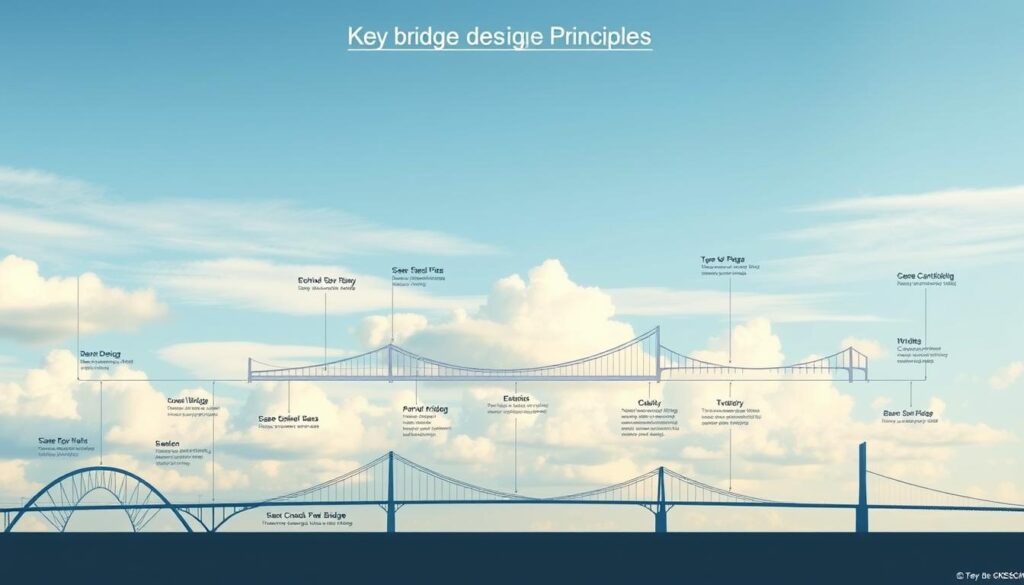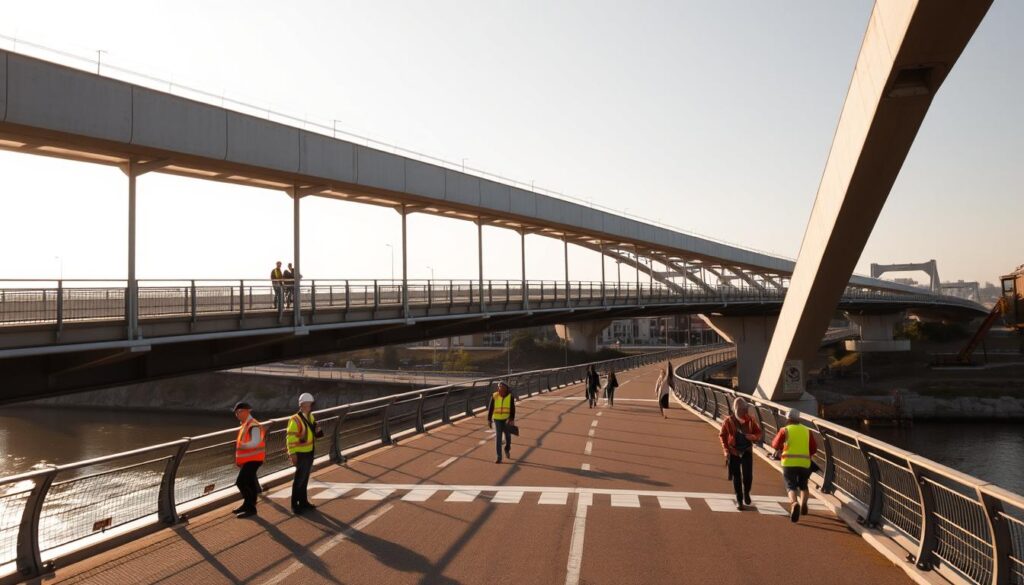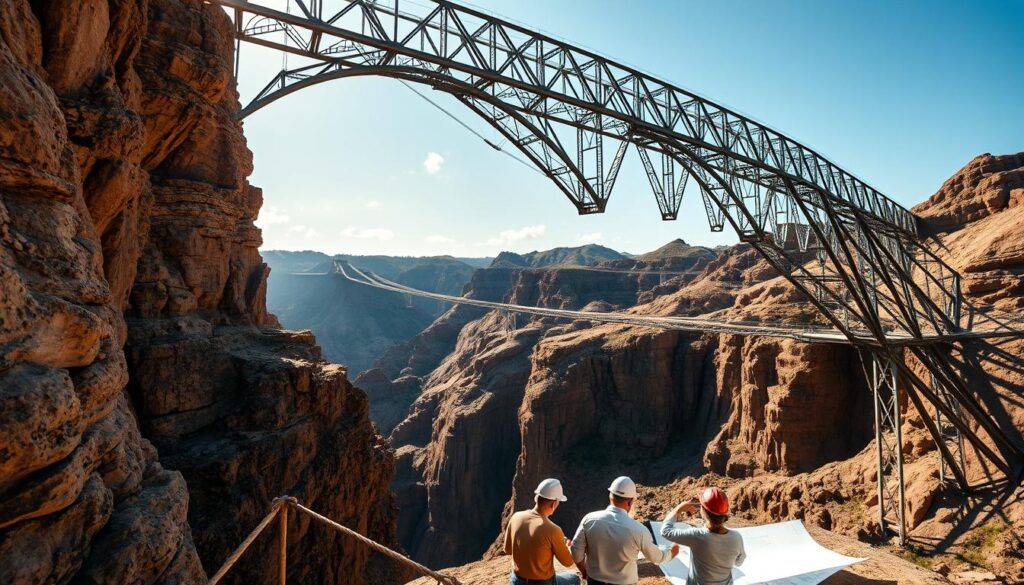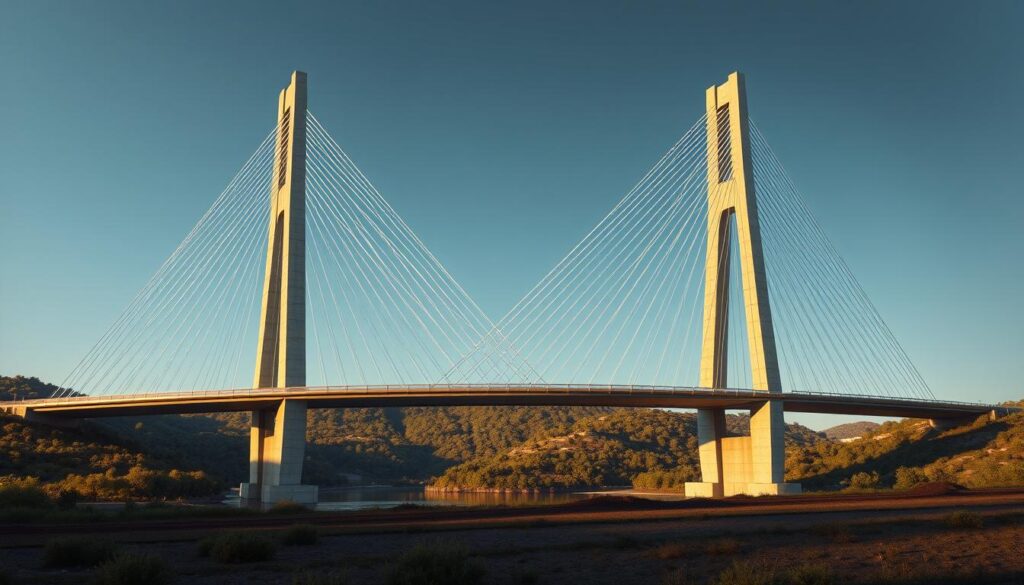The construction of bridges is a testament to human ingenuity, with over 600,000 bridges in the United States alone, according to the Federal Highway Administration.
Civil engineering plays a crucial role in the development of these structures, requiring meticulous planning and infrastructure development to ensure safety and durability.
The art of creating these complex structures involves a deep understanding of the intricate engineering considerations and adherence to building regulations.
Key Takeaways
- The importance of bridge construction in infrastructure development.
- The role of civil engineering in creating safe and durable bridges.
- The need for meticulous planning in bridge construction.
- The significance of adhering to building regulations.
- The complexity of bridge design engineering.
Introduction to Bridge Design Engineering
At its core, bridge design engineering is about creating safe, durable, and sustainable pathways over obstacles. This complex field combines various disciplines to ensure that bridges are not only functional but also aesthetically pleasing and environmentally friendly.
What is Bridge Design Engineering?
Bridge design engineering is a specialized branch of civil engineering that focuses on the planning, design, and construction of bridges. It involves a deep understanding of structural analysis, materials science, and geological factors to create bridges that can withstand various environmental conditions.
The process begins with a thorough analysis of the site, including geological surveys to understand soil composition and seismic activity. This initial step is crucial for determining the type of bridge that can be safely constructed.
Importance of Bridge Design in Infrastructure
Bridges play a vital role in modern infrastructure, facilitating the movement of people and goods across rivers, valleys, and other obstacles. Well-designed bridges can significantly enhance the efficiency of transportation networks, boost local economies, and improve connectivity between communities.
- Enhance transportation efficiency
- Support economic development
- Improve community connectivity
Overview of the Bridge Design Process
The bridge design process is multifaceted, involving several key stages:
- Site investigation and analysis
- Design conceptualization and planning
- Structural analysis and simulation
- Material selection and sustainability considerations
- Construction planning and execution
Each stage is critical to ensuring that the final product is safe, durable, and meets the required specifications. By understanding the complexities of bridge design engineering, engineers can create structures that not only serve their purpose but also contribute to the aesthetic and environmental quality of their surroundings.
Historical Context of Bridge Design
From ancient arches to modern suspension bridges, the evolution of bridge design is a fascinating story of innovation and perseverance. The historical context of bridge design engineering is marked by significant advancements in materials, techniques, and aesthetics.
Evolution of Bridge Engineering Techniques
The development of bridge engineering techniques has been a gradual process, influenced by the availability of materials and the challenges posed by different environments. Early bridges were often simple structures made from natural materials like wood and stone. The Romans, for example, were renowned for their sophisticated bridge-building techniques, using arches to distribute loads effectively.
As civilizations evolved, so did the techniques used in bridge construction. The introduction of iron and steel in the 18th and 19th centuries revolutionized bridge design, enabling the construction of longer and more complex structures. The development of suspension bridges, such as the iconic Brooklyn Bridge, marked a significant milestone in this evolution.

Iconic Historical Bridges and Their Design
Throughout history, bridges have not only served as critical infrastructure but also as symbols of engineering prowess and architectural beauty. The design of historical bridges often reflected the technological capabilities and aesthetic sensibilities of their time.
“Elegance in bridge design is not just about aesthetics; it’s also about the efficient use of materials and the integration of the bridge with its surroundings.” – Ian Firth
Iconic historical bridges, such as the Golden Gate Bridge and the Tower Bridge, continue to inspire modern bridge designers. These structures demonstrate the importance of combining functionality with aesthetic appeal.
Lessons Learned from Past Bridge Designs
Studying historical bridges provides valuable insights into the successes and failures of past designs. By analyzing these structures, engineers can identify best practices and common pitfalls, informing the design of future bridges.
| Bridge | Era | Notable Feature |
|---|---|---|
| Roman Arches | Ancient | Use of arches for load distribution |
| Brooklyn Bridge | 19th Century | Hybrid cable-stayed and suspension design |
| Golden Gate Bridge | 20th Century | Iconic suspension design and orange color |
The lessons learned from these historical bridges are crucial for advancing the field of bridge design engineering, ensuring that modern bridges are not only functional but also sustainable and aesthetically pleasing.
Types of Bridges and Their Applications
Different types of bridges are engineered to meet the demands of diverse landscapes and transportation requirements. The choice of bridge type depends on several factors, including the terrain, expected load, and environmental conditions.
Beam Bridges: Simplicity and Strength
Beam bridges are among the most common and simplest types of bridges. They consist of horizontal beams supported at each end by piers.
The simplicity of their design makes them cost-effective and easy to construct. Beam bridges are suitable for short to medium spans and are often used for roadways and railways.
Advantages of Beam Bridges:
- Cost-effective due to simple design and construction
- Easy to maintain and inspect
- Suitable for a variety of terrains
Arch Bridges: Aesthetic and Structural Benefits
Arch bridges have been a staple of bridge design for centuries, known for their aesthetic appeal and structural strength.
The arch shape distributes the weight evenly across the bridge, providing excellent stability. These bridges are often used in areas where aesthetics are a consideration.
The structural benefits of arch bridges include:
- Excellent load distribution
- High structural integrity
- Aesthetic appeal
Suspension Bridges: Engineering Marvels
Suspension bridges are renowned for their impressive spans and engineering sophistication. They consist of a deck suspended between towers by cables.
This design allows for long spans without intermediate supports, making them ideal for crossing wide bodies of water or deep valleys.
For more information on the different types of bridges, you can visit this resource, which provides detailed insights into various bridge types and their applications.
Key characteristics of suspension bridges:
- Long spans without intermediate supports
- Complex and costly construction
- Iconic and visually striking
Key Principles of Bridge Design
Effective bridge design hinges on a deep understanding of key principles that ensure both functionality and durability. These principles guide engineers in creating structures that are not only safe and efficient but also sustainable and aesthetically pleasing.

Load Distribution and Structural Integrity
The distribution of load across a bridge is critical to its structural integrity. Engineers must carefully analyze the types of loads a bridge will bear, including vehicular traffic, pedestrian use, and environmental factors like wind and earthquakes. Structural analysis involves assessing the bridge’s ability to withstand these loads without failing.
- Static loads refer to the weight of the bridge itself and any permanent features.
- Dynamic loads include the weight and impact of vehicles and pedestrians, as well as environmental forces.
By understanding these loads, engineers can design bridges with the necessary strength and resilience. For more information on the branches of engineering involved in bridge design, visit https://worldcivilsociety.com/branches-of-engineering/.
Material Selection and Sustainability
The choice of materials is pivotal to a bridge’s longevity. Engineers select materials that resist corrosion and accommodate local climate conditions. Material selection also involves considering the environmental impact of the materials used.
“The selection of materials for bridge construction is a critical decision that affects not only the bridge’s durability but also its environmental footprint.”
Sustainable materials and practices are increasingly important in modern bridge design. This includes using recycled materials, minimizing waste, and designing for recyclability at the end of the bridge’s life cycle.
Design Aesthetics and Functionality
While functionality is paramount, the aesthetic appeal of a bridge is also significant. A well-designed bridge can become a landmark and enhance the surrounding environment. Engineers work with architects to balance design aesthetics with functional requirements.
- Aesthetic considerations include the bridge’s form, color, and integration with the surrounding landscape.
- Functional requirements encompass safety, durability, and ease of maintenance.
By harmonizing these elements, engineers can create bridges that are both beautiful and functional, serving the needs of the community while enhancing the environment.
The Role of Technology in Bridge Design
Technological innovations have transformed the bridge design process, enabling engineers to create safer and more durable structures. The integration of advanced technologies has revolutionized the field of civil engineering, particularly in bridge design.
Computer-Aided Design (CAD) Software
Bridge design software, such as AutoCAD, has become an indispensable tool in modern bridge engineering. CAD software allows engineers to create detailed designs and models with precision. For instance, AutoCAD for civil engineering enables the creation of complex designs and simulations, improving the accuracy and efficiency of the design process.
“The use of CAD software has significantly reduced the time required for bridge design, allowing engineers to focus on other critical aspects of the project.” – Expert in Bridge Design
Simulation and Analysis Tools in Engineering
Simulation and analysis tools play a crucial role in assessing the structural integrity of bridges. These tools enable engineers to predict stress points, assess load distribution, and simulate various environmental conditions. By leveraging technological innovations in simulation software, engineers can optimize bridge designs to withstand natural disasters and other external factors.
- Finite Element Analysis (FEA) for stress analysis
- Dynamic simulation for assessing structural response to various loads
- Wind tunnel testing simulations for aerodynamic stability
Innovations in Materials Science
Advances in materials science have led to the development of new materials with enhanced properties, such as high-strength concrete and fiber-reinforced polymers. These materials contribute to the durability and sustainability of modern bridges. The application of civil engineering principles ensures that these materials are used effectively to improve bridge design.
| Material | Properties | Application in Bridge Design |
|---|---|---|
| High-Strength Concrete | High compressive strength, durability | Main structural elements, piers, and abutments |
| Fiber-Reinforced Polymers | High tensile strength, corrosion resistance | Structural reinforcement, deck slabs |
The role of technology in bridge design is multifaceted, encompassing CAD software, simulation tools, and innovations in materials science. By embracing these technological innovations, engineers can create bridges that are not only structurally sound but also aesthetically pleasing and sustainable.
The Importance of Safety in Bridge Engineering
Safety is paramount in bridge engineering, where the consequences of failure can be catastrophic. The design and construction of bridges involve complex engineering challenges, and ensuring the safety of these structures is crucial for protecting the public and the environment.
Safety Standards and Regulations
Bridge engineering is governed by stringent safety standards and regulations that vary by country and region. In the United States, for example, the American Association of State Highway and Transportation Officials (AASHTO) provides guidelines that are widely adopted. These standards cover various aspects, including design loads, material specifications, and construction practices.
Compliance with safety regulations is not only mandatory but also essential for ensuring the structural integrity and durability of bridges. Engineers must stay updated with the latest standards and apply them rigorously during the design and construction phases.
Risk Assessment Methods
Risk assessment is a critical component of bridge engineering, involving the identification and mitigation of potential hazards. Engineers use various methods, including probabilistic risk assessment and deterministic analysis, to evaluate the safety of bridge designs.
- Identifying potential failure modes
- Analyzing the impact of natural disasters
- Evaluating the effects of material degradation
By understanding these risks, engineers can implement design measures to mitigate them, such as using redundant systems or enhancing the structural capacity.
Case Studies of Bridge Failures
Despite rigorous safety measures, bridge failures have occurred throughout history, often with devastating consequences. Analyzing these failures provides valuable lessons for improving safety practices.

For instance, the collapse of the Tacoma Narrows Bridge in 1940 highlighted the importance of aerodynamic stability in bridge design. More recently, the failure of the Morandi Bridge in Italy in 2018 underscored the need for regular maintenance and inspection.
These case studies serve as critical learning tools, helping engineers to refine their designs and safety protocols.
The Environmental Impact of Bridge Design
The interplay between bridge design and environmental sustainability is a critical consideration in modern engineering. As infrastructure development continues to grow, the need to minimize the ecological footprint of bridges has become increasingly important.
Responsible bridge design must take into account the potential environmental impacts, implementing practices that reduce harm to local ecosystems. This involves a comprehensive assessment of ecological effects and the adoption of sustainable design practices.
Assessing Ecological Effects
Assessing the ecological effects of bridge design involves evaluating how the structure will interact with its environment. This includes studying the local wildlife, water flow, and soil conditions to predict potential impacts.
Ecological assessments are crucial for identifying measures to mitigate adverse effects. For instance, designing bridges with wildlife passages can help maintain habitat connectivity, reducing the impact on local species.
Sustainable Bridge Design Practices
Sustainable bridge design practices are essential for minimizing environmental impact. These practices include using eco-friendly materials, optimizing structural efficiency, and incorporating features that support local biodiversity.
For example, using sustainable materials such as recycled steel or locally sourced timber can reduce the carbon footprint of bridge construction. Additionally, designing bridges with minimal environmental disruption in mind can help preserve natural habitats.
Mitigating Environmental Impact
Mitigating the environmental impact of bridges requires a multifaceted approach. This includes implementing erosion control measures, managing water runoff, and ensuring that the bridge design does not adversely affect local water quality.
By adopting sustainable design practices and conducting thorough ecological assessments, engineers can significantly reduce the environmental footprint of bridges. This not only benefits the environment but also contributes to the long-term sustainability of infrastructure projects.
The Role of Engineers in Bridge Design
In the realm of bridge design, engineers are at the forefront, driving projects forward through meticulous planning and collaboration. Their role is multifaceted, involving not just the technical aspects of bridge construction but also coordination with various stakeholders.
Collaboration with Architects and Planners
Engineers work closely with architects and planners to ensure that the bridge design is both aesthetically pleasing and functionally viable. This collaboration is crucial in creating a bridge that not only serves its purpose but also complements its surroundings. For instance, the design of the Golden Gate Bridge in San Francisco is an iconic example where engineering and architectural expertise merged to create a landmark.

To learn more about the responsibilities of bridge engineers, visit https://usbridge.com/what-does-a-bridge-engineer-do/.
Project Management in Bridge Construction
Project management is another critical aspect of an engineer’s role in bridge design. This involves overseeing the construction process, managing timelines, and ensuring that the project stays within budget. Effective project management requires a deep understanding of construction methodologies, materials, and labor laws. For detailed insights into managing civil engineering projects, refer to https://worldcivilsociety.com/how-to-manage-a-civil-engineering-project/.
| Project Management Aspect | Description | Importance |
|---|---|---|
| Timeline Management | Overseeing the construction schedule | High |
| Budgeting | Managing financial resources | High |
| Quality Control | Ensuring construction meets standards | Very High |
Continuing Education and Professional Development
The field of bridge design engineering is constantly evolving, with new technologies and materials being introduced regularly. Therefore, continuing education is vital for engineers to stay updated with the latest developments. This can involve attending workshops, seminars, and pursuing advanced degrees. By doing so, engineers can enhance their skills and contribute to more innovative and sustainable bridge designs.
Engineers must also adhere to professional development standards, ensuring their practices are aligned with current regulations and best practices. This not only enhances their professional credibility but also contributes to the overall safety and efficiency of bridge projects.
Challenges in Modern Bridge Design
The art of bridge design is increasingly complicated by various factors, making it a complex task that requires careful consideration of multiple challenges.
Modern bridge design faces a multitude of challenges, from financial limitations to the need to adapt to a changing climate. These challenges necessitate innovative solutions and a deep understanding of both the technical and environmental aspects of bridge engineering.
Budget Constraints and Financial Planning
One of the significant challenges in modern bridge design is managing budget constraints. The cost of materials, labor, and compliance with regulations can be substantial. Effective financial planning is crucial to ensure that projects are completed on time and within budget.
To mitigate the impact of budget constraints, engineers and project managers must work together to identify cost-effective solutions without compromising the quality and safety of the bridge.
| Cost Component | Percentage of Total Cost | Average Cost |
|---|---|---|
| Materials | 40% | $1 million |
| Labor | 30% | $750,000 |
| Regulatory Compliance | 10% | $250,000 |
| Miscellaneous | 20% | $500,000 |
Urbanization and Space Limitations
Urbanization poses another significant challenge, as it often results in space limitations that complicate bridge design. Engineers must navigate these constraints while ensuring that the bridge is both functional and safe.
In densely populated urban areas, the need to minimize disruption to traffic and other infrastructure can further complicate the design process. Innovative design solutions are required to meet these challenges.
Emerging Climate Considerations
Climate change is increasingly influencing bridge design, as engineers must now consider the potential impacts of rising sea levels, more frequent extreme weather events, and other climate-related factors.
Designing bridges that can withstand these challenges requires a forward-thinking approach, incorporating the latest research and climate models to ensure resilience and sustainability.
By understanding and addressing these challenges, engineers can develop bridge designs that are not only safe and functional but also sustainable and resilient in the face of a changing climate.
Case Studies of Modern Bridge Projects
Bridge design engineering has witnessed a paradigm shift with the incorporation of advanced materials and techniques. Modern bridge projects are not only feats of engineering but also showcase innovative designs that prioritize sustainability, aesthetics, and functionality.

Iconic American Bridges: Analysis and Design
The United States is home to numerous iconic bridges that have become symbols of engineering excellence. For instance, the Golden Gate Bridge in San Francisco is a suspension bridge that has withstood the test of time since its completion in 1937. Its design has been studied extensively, and it continues to inspire modern bridge projects.
Another example is the Brooklyn Bridge in New York City, which was one of the earliest suspension bridges in the United States. Its hybrid cable-stayed/suspension design has been a subject of study for many engineers, and it remains an important part of the city’s infrastructure.
Lessons from Renowned Design Firms
Renowned design firms such as those listed among the top 10 civil engineering firms in the have contributed significantly to the field of bridge design. These firms have worked on numerous high-profile projects, pushing the boundaries of what is possible in bridge engineering.
Their experiences and innovations provide valuable lessons for future bridge projects. For example, the use of advanced materials like fiber-reinforced polymers (FRP) and high-performance concrete has become more prevalent, offering improved durability and reduced maintenance costs.
Innovations in Recent Bridge Projects
Recent bridge projects have seen the introduction of innovative designs and technologies. For instance, the use of computer-aided design (CAD) software has enabled engineers to create complex designs that were previously impossible to achieve. Additionally, simulation and analysis tools have improved the safety and efficiency of bridge construction.
One notable example is the Millau Viaduct in France, which, although not in the United States, has influenced bridge design globally. Its slender design and use of advanced materials have set a new standard for bridge construction.
Future Trends in Bridge Design Engineering
The next generation of bridge design engineering will be characterized by smart technologies and climate resilience. As the world grapples with the challenges of infrastructure development and environmental sustainability, the field of bridge engineering is evolving to meet these demands.
Advancements in Smart Bridge Technologies
Smart bridge technologies represent a significant leap forward in bridge design engineering. These innovations include the integration of sensors and monitoring systems to track the structural health of bridges in real-time. Such technologies enable predictive maintenance, reducing the risk of catastrophic failures and extending the lifespan of bridges.
The use of advanced materials and construction techniques also plays a crucial role in smart bridge technologies. For instance, the application of fiber-reinforced polymers (FRP) and other durable materials can significantly enhance the structural integrity and longevity of bridges.
“The integration of smart technologies into bridge design is not just a trend; it’s a necessity for creating resilient and sustainable infrastructure for the future.” – Expert in Bridge Engineering
Prospects for Modular Bridge Construction
Modular bridge construction is another future trend gaining traction in bridge design engineering. This approach involves prefabricating bridge components in a factory and assembling them on-site, which can significantly reduce construction time and minimize environmental disruption.
| Benefits | Modular Construction | Traditional Construction |
|---|---|---|
| Construction Time | Reduced | Extended |
| Environmental Impact | Minimized | Significant |
| Quality Control | Enhanced | Variable |
Preparing for Climate Resilience
As climate change continues to pose significant challenges, bridge design engineering must prioritize climate resilience. This involves designing bridges that can withstand extreme weather events, such as floods and storms, and adapting to rising sea levels.
Key strategies for enhancing climate resilience include using climate-resilient materials, elevating bridge structures where necessary, and incorporating flood-resistant designs.
By embracing these future trends, bridge design engineering can play a pivotal role in creating a more sustainable and resilient infrastructure for generations to come.
Interdisciplinary Approaches in Bridge Engineering
Interdisciplinary collaboration is revolutionizing bridge engineering, leading to more sustainable and resilient structures. By integrating diverse fields of expertise, bridge engineers can now design and construct bridges that not only meet but exceed modern standards.

Collaboration with Environmental Scientists
One crucial aspect of interdisciplinary bridge engineering is collaboration with environmental scientists. This partnership ensures that bridge designs minimize ecological disruption and promote biodiversity. For instance, environmental impact assessments can identify potential risks to local wildlife, allowing engineers to adapt their designs accordingly. A study on interdisciplinary projects highlights the benefits of such collaborations in achieving sustainable outcomes.
Engaging with Community Stakeholders
Engaging with community stakeholders is another vital component of interdisciplinary bridge engineering. By involving local residents and businesses in the design process, engineers can better understand community needs and preferences. This not only fosters a sense of ownership among stakeholders but also leads to more functional and aesthetically pleasing bridge designs. Effective community engagement can be seen in projects that prioritize public participation and incorporate feedback into the design process.
Integrating Urban Planning and Bridge Design
Integrating urban planning with bridge design is essential for creating cohesive and efficient transportation networks. By considering the broader urban context, engineers can design bridges that complement existing infrastructure and support future development. This holistic approach can enhance the overall livability of urban areas and promote sustainable growth. For more insights on the role of civil engineering in urban development, visit World Civil Society.
The future of bridge engineering lies in its ability to adapt and evolve through interdisciplinary approaches. By embracing collaboration across disciplines, the field can continue to innovate and address the complex challenges of the modern world.
The Role of Government in Bridge Engineering
The government plays a pivotal role in bridge engineering through various mechanisms. Effective bridge construction and maintenance require not only technical expertise but also significant governmental support.
Funding and Infrastructure Development
Government funding is essential for bridge engineering projects. The allocation of funds determines the scope and scale of infrastructure development. Governments can invest in new technologies and materials, enhancing the durability and sustainability of bridges.
Key funding mechanisms include:
- Government grants
- Public-private partnerships
- Federal and state transportation funds
Regulatory Framework and Policy Making
A robust regulatory framework is crucial for ensuring the safety and quality of bridge engineering projects. Governments establish and enforce standards, regulations, and policies that guide the design, construction, and maintenance of bridges.
| Regulatory Aspect | Description | Impact |
|---|---|---|
| Safety Standards | Guidelines for design and construction | Ensures public safety |
| Environmental Regulations | Rules to minimize ecological impact | Protects natural habitats |
| Building Codes | Standards for materials and construction practices | Ensures structural integrity |
Promoting Public-Private Partnerships
Governments can foster public-private partnerships (PPPs) to leverage additional resources and expertise for bridge engineering projects. PPPs can enhance efficiency, reduce costs, and improve project outcomes.
The benefits of PPPs include:
- Increased efficiency
- Cost savings
- Innovation through private sector expertise
In conclusion, the government’s role in bridge engineering is multifaceted, involving funding, regulation, and partnership promotion. By understanding and leveraging these elements, governments can significantly impact the success and sustainability of bridge infrastructure projects.
Conclusion: The Future of Bridge Design Engineering
The bridge industry has shifted its focus towards intelligent 3D models, enhancing data quality, collaboration, and operational aspects, including asset management. As the field continues to evolve, it’s essential for aspiring engineers to learn from current practices and stay updated with the latest advancements.
Embracing Lifelong Learning
The importance of lifelong learning cannot be overstated in bridge design engineering. With the increasing complexity of bridge projects, engineers must continue their education to stay abreast of new technologies and methodologies, such as intelligent 3D modeling and smart bridge technologies.
Inspiring Future Generations
As we look to the future of bridge design engineering, it’s crucial to inspire the next generation of engineers to contribute to this dynamic field. By emphasizing the importance of collaboration, innovation, and sustainability, we can ensure that future bridge projects are not only structurally sound but also environmentally responsible and aesthetically pleasing.
